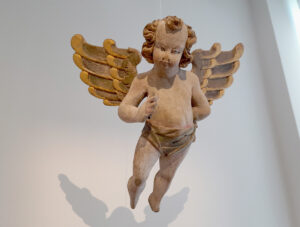The visually remarkable – Hardy Strid and Bauhaus Situationiste at Drakabygget
In Hallands Konstmuseum´s collection there are archive documents which belonged to the Halmstad artist Hardy Strid. It is very diverse material. Among other things we find documents which tell us about the artist´s collective Bauhaus Situationiste who created an experimental art scene on the farm Drakabygget outside Örkelljunga in the 1960´s and -70´s. The Danish brothers Asger Jorn and Jörgen Nash bought the farm in 1960 in order to create a self supporting artist´s collective. They were both part of the International Situationism movement. Influensed by marxism, anarchism and the Dada movement from the early 20th century, the aim was to challenge the definition of art. Not as a prolongation av power and capital, but rather as an incorporated part of society, with and for everybody. Drakabygget became a meeting point for the Scandinavian-German fraction of the Situationists. But also for artists from other parts of the world, who shared the ideology about the playful human, Homo Ludens, where art and play were to liberate humanity from everyday conventions and create a better society.
In a showcase, a sample from the archive about Drakabygget is shown. Hardy Strid was one of the collective´s most engaged artists.
Some photos show him creating his art. In one of them he´s using a chain saw to cut up large logs lengthways. In another, he stands spinning a home made wheel of fortune in front of laughing kids. On one of the larger sectors in the wheel of fortune it says Bauhaus Situationiste. Den funktionella fantasien, the functional fantasy.
To the right of the photos we find what is called mail art. The term stands for small pieces af art with an informal and personal character which were sent by mail. Those were made by the Japanese artist Yoshio Nakajima och have to do with his participation in the contemporary art exhibition Documenta in Kassel 1972. This was one of the first big international exhibitions that showed a wider art expression, including for example performance and happenings. The art was to move out of its museal context and be provocative. In the showcase lies a large envelope with the names of several of the Bauhaus Situationiste members, alongside a collage with stamps, a photography of the artist and a ringlet of his hair. We also find a very small dried fish tied to a homemade postcard with a unique stamp reading International Happenings and Nakajima State.
In the case is also an inivitation from 1965 to a situationistic filmfestival on the cinema Figaro inside Halmstad Theatre. The night was to end up at Hotel Svea with discussion, jazz and dancing.
On the wall behind, a little to the left, is a work of art by Hardy Strid. It is called Manifesto and is a combination of a painting and a collage. Against a dark background is a symmetric shape in white, some black and red. It can remind of something inside the body, maybe a pelvis or a utero, but seems at the same time quite spontaniously made. As if the artist simply poured out some paint on a canvas and double folded it, hence the perfect symmetry. On both sides of the shape are photographs, illustrations, some playing cards and textual cutouts in three numbered lines. ”5. det oviktiga”, ”4. moraliserar”, ”3. flera spår”. That translates ”the irrelevant – moralises – several tracks”. The other elements in the painting are also numbered, which can cause us to try and crack the code to what we recognise as some system. However, the work may be totally free of such implied meanings and more of an example of what the Frenchman André Breton wrote about automatism in the first Surrealist Manifesto in 1924: The thought´s dictation, free from any control by the reason, independant of any aesthetic or moral preoccupation.








